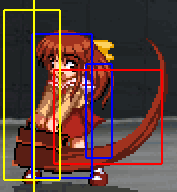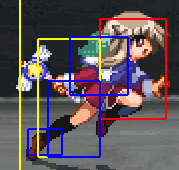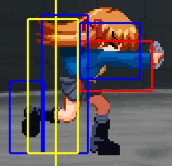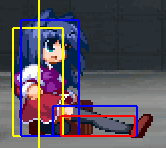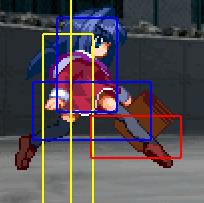Eternal Fighter Zero/Recoil Guard
Jump to navigation
Jump to search
An In-Depth Introduction To Recoil Guard in Eternal Fighter Zero
What is Recoil Guard?
- Put simply, Recoil Guard (RG) is a strictly timed block - it is done by blocking within 10 frames before an attack hits the player. A successful RG will negate pushback, chip damage, blockstun (allowing you to recover and attack much sooner than just blocking) and finally make it possible to guard against air unblockable attacks. In order to successfully RG an attack, you must RG moves accordingly: highs must be RG'd standing, lows must be RG'd crouching, while mids can be RG'd in either state.
- Mizuka's famous overhead must be RG'd standing.
- Another important aspect of RG is the inability to RG consecutive hits while grounded. If you have just RG'd a move, you must either block a move normally or wait for a fixed time for the RG cooldown to pass before being able to RG again. In the air, this restriction is not applied - you can RG as many hits as you want consecutively.
Counter Recoil Guard (otherwise known as Recoil Counter)
- This is where things get a little bit complicated to explain, so I'll be using a video to help illustrate this.
- If you RG an opponent’s attack and you attempt to attack during their recovery frames they will be allowed to RG back. As long as the move that the defending player RG'd is still in recovery frames, the attacking player will be able to RG any counter attacks made. This is called Counter RG (cRG). In the video example, we can see this in action. Both Nayuki's are able to RG the opponent's 5C's during 5C's recovery frames, until player 2 messes up the RG timing and takes a hit. This "RG Battle" can go on forever if both players let it, but in competitive matches this is very unlikely to happen.
What makes it so difficult?
- First and foremost, newer players will be attempting to RG consciously. In an already complex environment, the game demands that players are familiar with and can adequately use RG - if they can't, they're going to have a difficult time, especially if the opponent can. The first barrier is building the muscle memory to attempt RGs subconsciously so the player is able to focus on the other aspects of an already complicated match.
- Secondly, there is no absolute guard, so letting go of block to RG can result in you getting hit even if you’re in blockstun. While the RG buffer window is fairly large (10F), it's still exceptionally difficult to time during blockstrings without getting hit, especially if there are multiple hit moves involved like Akane's 5C or Mio's Short Range 2B.
- Most importantly, it requires situational awareness in a game with 22 tournament legal characters. How you use RG (and what move you use out of RG, if any) will change drastically depending on the matchup, meter (of both players), positioning, and the opponent's available cancel options. Choose wrong and you'll likely be eating a combo that does 40% damage or more, sometimes up to 80%.
Using Recoil Guard - The How's, Why's, and When's
- In order to use RG effectively, we need to understand how it works under the hood.
RG Hitstop (Defender) RG Hitstop (Attacker) Defender Disadvantage Stand RG 20F 19.66F -0.33F Crouch RG 22F 19.66F -2.33F Air RG 22F 20F -2.00F
- Blockstun duration can vary drastically depending on the frame data of the attack. For instance, Akane's 5A causes 10F of blockstun, while Misaki's 5A causes 12F. RG, on the other hand, applies the same RG stun no matter what move it is. In the table above, you can see that the defender will always be -0.33F disadvantage for Stand RG, and -2.33F disadvantage for crouch RG, while air RG is -2F. This means that the attacker can act 0.33F or 2.33F earlier than the defender if they have a cancel option.
- It’s almost like your attack out of RG has an extra 0.33F or 2.33F startup depending on the RG used, but that’s not quite right. Only directions can be buffered during RG stun, not attack buttons, so your attack out of RG will be 0.33F or 2.33F slower at best, assuming perfect timing. As perfect timing cannot be guaranteed, the longer the window to input your attack out of RG the easier (and more match viable) it will be to punish.
RGing Specials and Supers
- Special attacks and supers usually have only one cancel option, Instant Charge, meaning that if the attacker's special attack gets RG'd (and assuming it has long enough recovery to be punishable) they'll be a sitting duck where their only out is spending meter to make themselves safe (if they even have any) or to correctly time a counter RG (giving the defender the opportunity to steal the turn if they can come out on top of the RG battle).
- Sayuri's 41236A is a frustrating move that leads to infinite blockstrings if you don't know how to RG. If spaced correctly, it's insanely plus on block and essentially unbeatable. On RG however, Sayuri has no choice but to try and counter RG the defender's attack or else take a hit as she is stuck in 41236A's recovery while the defender has already recovered from RG stun and is able to act. 23F of blockstun turns into 0.33F or 2.33F of RG stun depending on if the defender used stand or crouch RG. Sayuri's 41236A has between 13F and 24F of recovery depending on what active frame the move hits on. 5As and 2As are usually between 4F and 7F, so the defender will have ample time to counter and potentially steal the turn.
- Some exceptions for the special cancel rules exist, such as rekka type attacks (Mio Short Range 236*) and some moves with unique cancel properties (Mio Short Range j2C and Kaori 623B). For moves with fast, consecutive hits, you should almost always be aiming to RG the final hit of the move.
RGing Dash Normals
- Dash normals usually have a total of three cancel options: Special, Super and Instant Charge. Let's take a look at Makoto's 66B:
- If we were to block Makoto 66B normally, we wouldn't be able to do much at all - it's +2F on block, allowing Makoto to beat any moves we try to use (that aren't reversals). If we RG though, it's an entirely different story.
- Makoto 66B has 10F of recovery. It's only cancel options are into specials, supers or Instant Charge, all of which require a large commitment of risk or resources. If Makoto chooses not to cancel into any of these options, the only option left is to counter RG. Let's take Sayuri as her opponent. If Sayuri crouch RGs 66B, she'll be unable to act for 2.33F, after which she'll be able to input anything. This gives her 7.66F to counter attack before Makoto recovers in time to block. If Sayuri stand RGs, she's unable to act for 0.33F, meaning Sayuri has a total of 9.66F to punish. Sayuri's 2A and 5A are both 4F startup, meaning that Sayuri can punish 66B easily just by RGing into 5A or 2A. This same rule applies to most of the game's dash normals!
- Here, you can start to see a pattern. We're aiming to RG moves that have few low-risk cancel options and have enough recovery to be punishable on RG (either by getting hit or forfeiting the turn). This is what makes specials, supers, and dash normals such a perfect RG target.
RGing Normals
- Things become a bit trickier when trying to RG normals. Depending on how low in the cancel chain the attacker is (A>B>C>D>Special=Super), the more chance they have of being unbeatable even with RG. When there's cancel options it's a race where the fastest attack wins.
- Let's say Sayuri crouch RGs Nayuki's 2A. As we've determined before, Sayuri's fastest normals are her 2A and 5A at 4F startup. Nayuki recovers 2.33F faster than Sayuri, and cancels her 2A recovery into yet another 2A, her fastest cancel option. Because Nayuki’s 2A is 5F startup, we'll be 1.33F too slow to counter attack with 2A or 5A, Sayuri loses the race. Trying to RG a 2A and counter with normals is therefore bad, we can't win assuming they play it right.
- But what if Sayuri RGs Nayuki f5B? Nayuki's low commitment cancel options out of f5B are as follows:
- If Sayuri crouch RGs, we'll be able to beat both of these options with 5A if we time it right! If Sayuri stand RGs f5B, we'll be in an even better position, as stand RG only leaves us at -0.33F disadvantage, essentially giving Sayuri a 7.66F window to counter attack and punish if the Nayuki player chooses to cancel into her fastest, low commitment cancel option. But Nayuki also has the following high commitment cancel options:
- These are her fastest cancel options available from any normal, and these become a lot less risky if the attacker has Instant Charge in stock. One of the attacker's options to keep their turn going is to go straight into 623A IC after their f5B is RG'd, if timed correctly this will be unbeatable unless the defender uses a reversal.
- 623B is another story entirely. While it's 2F slower, it does have the added bonus of a huge area of upper body invulnerability from frame 1, allowing Nayuki to beat Sayuri's 5A, but still loses to stand RG 2A if Sayuri doesn’t miss the timing.
RG Mind Games
- Not attacking out of RG is just as much of an option as attacking is. Let's return to the Makoto 66B example. The defender guesses correctly that the attacker will take a risk and cancel into 623C after the defender RGs 66B, what can the defender do to counter this? Simply block. Assuming the attacker only has access to red RF meter, they wont be able to Instant Charge the attack and can be easily punished once 623C has finished it's active frames, leaving the defender with a total of 39F of recovery to punish with. Better yet, because the defender regular blocked 623C instead of RGing, the attacker cannot counter RG, making the punish completely risk free. This is why it's rare for attackers to cancel dash normals into specials without access to Instant Charge, it's usually far too risky to justify the reward.
When You Shouldn't RG
- Using RG isn't always the best option. If the defender RGs, this also gives the attacker a chance to save themselves with counter RG. Sometimes moves are so unsafe even on block that RGing gives your opponent an advantage, one example being Akiko's 623B which is -52F on block and leaves Akiko in the air, allowing for high damage combo starters. RGing this move gives Akiko one out - managing to guess when your attack will hit during her 64F total of recovery. It is therefore better to block certain moves with huge amounts of recovery.
Choosing Your Counter Attack
- RG is like a complex game of rock, paper, scissors. Let's take RGing a 2A with a character who has a fully invulnerable EX reversal.
- Attacker's 2A beats defender's 2A.
- Attacker's 2A loses to defender's block.
- Attacker's 2A loses to defender's EX reversal.
- Attacker's counter RG beats defender's EX reversal.
- Attacker's longer lasting invulnerable super beats defender's EX reversal.
- And so on.
- Each option has a certain amount of risk and reward which is far too complicated to simplify. For instance, if either player has access to Blue Instant Charge they may be able to use a fully invulnerable EX reversal and cancel into an Instant Charge to make it completely safe. If it hits, they'll get a lot of damage from the Blue Instant Charge combo, and if the opponent blocks or RGs they'll likely be safe.
- Due to the complexity and infinite variety of situations, learning these details cannot be done through a general guide like this one, your best bet is to play and experience the situations yourself, making use of the knowledge learned here to review your replays and assess individual scenarios to see what you could have done better.
Winning Recoil Guard Battles
- RG battles are a bit like a tug of war, both sides are trying to get the right leverage to come out on top. In RG battles, coming out on top either means the attacker keeping their turn or the defender stealing the turn. Any RG is a potential initiation of an RG battle, one the attacker may or may not have the choice to avoid - in some situations they're still safe and can relinquish their turn without any huge risk, potentially preferring to return to neutral, or to wait for an opportunity to RG a potentially risky move of the opponent's like we discussed above and initiate an RG battle once again, hoping this time they can come on top and force a preferable position. But how does the attacker optimise their pressure to fight RG? Here's a few tips:
- Keep your pressure relatively RG safe by using only A and B normals.
- Mix up the timings of your attacks to make it more difficult for your opponent to guess when to RG. The downside to this is if you do it badly you leave gaps where the opponent can mash.
- Make use of Instant Charge to make unsafe moves safe and continue pressure.
- Along with the above, you can use invulnerable moves into an Instant Charge after a normal gets RG'd in order to beat any possible punish and still come out with pressure advantage depending on your character.
In Conclusion
- Recoil Guard is a complex mechanic with very few universal rules or applications, making it difficult to grasp at first. This guide has not gone over everything. There is always more to say, always another situation to discuss, another exception to mention, matchup specific scenarios to explore that you won't see anywhere else. Your best option to learn is to play as much as you can and experience the situations first hand.
